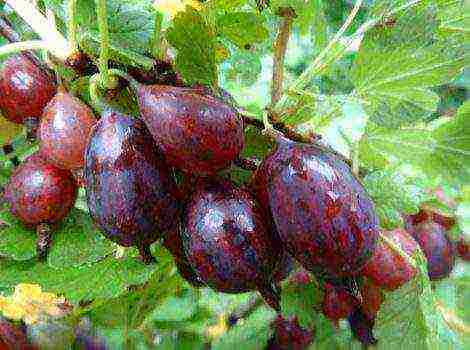Content
- 1 Sweet potato varieties with light flesh (white, cream, yellowish)
- 2 Sweet potato varieties with orange flesh
- 3 Sweet potato varieties with purple flesh
- 4 What is sweet potato and why to grow it
- 5 Sweet potato varieties, their yield and taste
- 6 The sweetest sweet potatoes for your garden
- 7 How to properly grow sweet potatoes with low solar activity
Not everyone is engaged in the cultivation of sweet potatoes, considering that this culture does not take root well in our latitudes. However, practice proves the opposite - knowing the peculiarities of cultivating "sweet potatoes" and choosing the right variety, you can get a good harvest even at home. Among the advantages of growing sweet potatoes, it is worth noting high yield, resistance to diseases and pests, excellent taste and nutritional qualities.
In addition, there are many sweet potato varieties, so every gardener can choose a hybrid that suits their specific requirements for flavor, growing season and other characteristics.
Features of sweet potato
Sweet potato belongs to the family of bindweed plants and is a long liana with lush leaves, in the internodes of which edible tubers are formed. The yield of this crop is higher than that of ordinary potatoes - from 1 hectare you can harvest up to 50 tons of tubers and another 500 quintals of leaves and stems, which are used as animal feed. Sweet potatoes usually grow up to 30 m in length and can weigh between 200 g and 3 kg, while in warmer countries, such as Colombia and Peru, they can grow up to 10 kg.
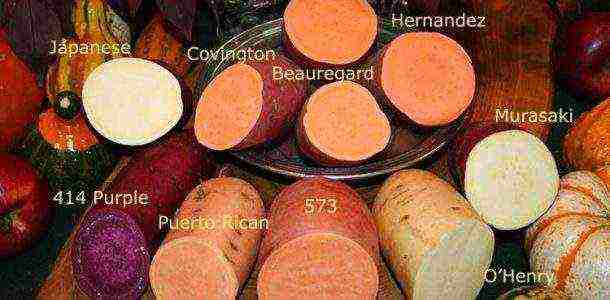
As for the sweet potato varieties, they are divided into three main groups:
- dessert;
- vegetable;
- fodder.
Between themselves, they differ in the concentration of glucose and, accordingly, in taste, the color of the pulp and the demand for heat.
back to content ↑ Dessert sweet potatoes
Dessert sweet potato varieties are characterized by a high content of glucose and beta-carotene, which is why they are sweet in taste and have a bright yellow or orange flesh. Such hybrids require a lot of heat and sunlight to ripen, so they grow well in the subtropics and somewhat worse in the middle lane.
Sweet potato tastes and aromas vary by variety and may resemble pineapple, banana, carrot, chestnut, or pumpkin. After heat treatment, the heart of the "sweet potato" becomes soft, creamy and very tender. Such tubers go well with nuts, fruits, molasses, caramel, they are suitable for making various desserts, sweet cereals and casseroles, and even wines.
The most popular sweet potato varieties are:
Back to contents ↑ Georgia red

A very productive variety that ripens relatively quickly and is suitable for growing in the middle lane and southern regions. Forms a compact shrub with dark red leaves, on which rounded tubers are formed. The fruits have predominantly light flesh and, when raw, hardly differ from potatoes, but when baked they become soft and sweet.
back to contents ↑ Kumara ed
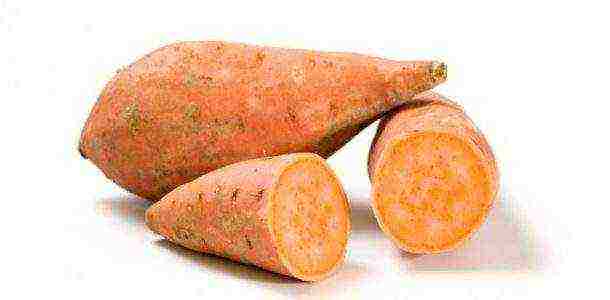
Forms large bushes with long vines and lush leaves. Tubers are oblong, rounded, light core with a yellow tint. The taste of this sweet potato variety is moderately sweet, slightly tart when raw. The hybrid is demanding on temperature and lighting.
back to contents ↑ Victory 100
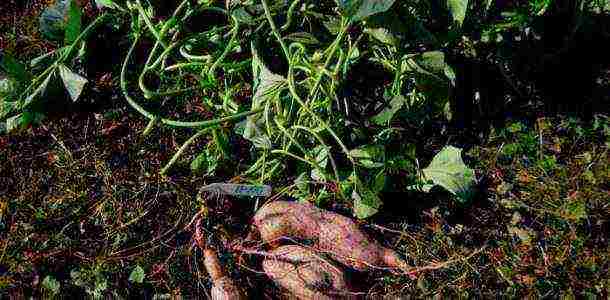
An early ripening fruitful variety that takes root well in the middle lane and in the southern regions. Forms a compact bush, so it can be planted densely. Tubers with orange flesh, even, smooth and resembling potatoes. Fruit taste is moderately sweet, similar to a combination of banana and nuts. After picking, the tubers must lie down for some time to acquire sweetness; immediately after digging up, they are tasteless.
Back to contents ↑ Beauregard
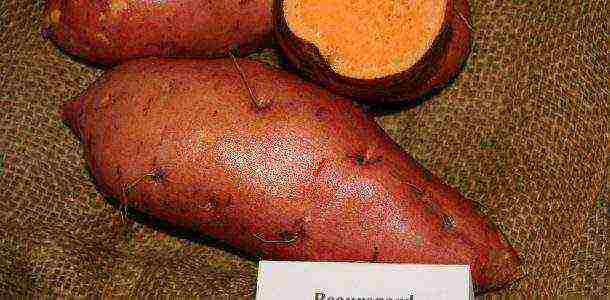
It is characterized by a high content of carotene and glucose, it is very sweet and tasty. This variety forms compact bushes that are not afraid of thickened plantings. The tubers are smooth, with a copper skin and orange flesh. Very easy to care for and recommended for beginners to grow.
to the content ↑ Vegetable varieties
Vegetable sweet potatoes have a lower glucose concentration than dessert ones, so they are less sweet and more like potatoes. It takes root well in the middle lane and gives a good harvest. The tubers have a light flesh interspersed with yellow, pink or orange. When baked and boiled, this sweet potato becomes soft, tender and juicy. Most hybrids are not very suitable for frying due to some wateriness, but they make great purees, casseroles, side dishes and other dishes.
The most common varieties of vegetable sweet potatoes are:
Back to contents ↑ Japanese
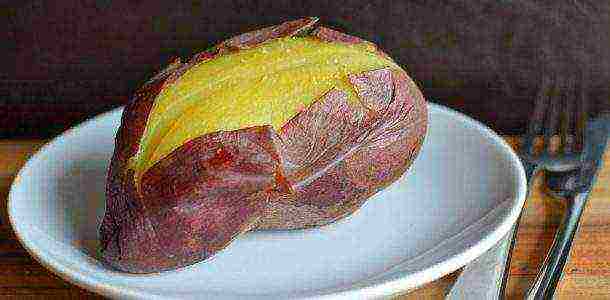
An early hybrid, ripening in 90-100 days, with an average yield. Forms large shrubs with long stems and slightly cut leaves. The tubers have a red skin and yellowish flesh with a mild aroma, they are well stored and cook quickly. The taste of the fruit is very similar to potatoes, but brighter.
back to contents ↑ Purple
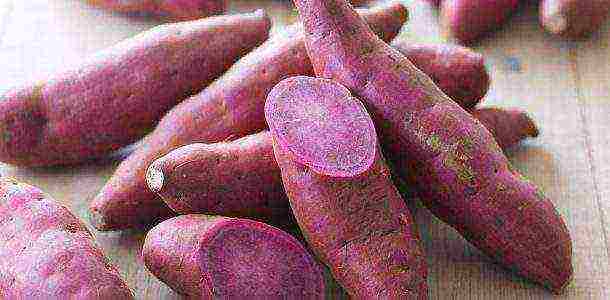
An early variety (vegetation period of 90 days), characterized by an average yield and resistance to pests and diseases. Forms a powerful bush with long branches and dark green leaves. The tubers have a beautiful purple color of the skin and pulp, which remains after heat treatment. There is almost no sweetness in the taste, but a hint of chestnut is felt. In terms of nutritional and taste qualities, this sweet potato variety is superior to potatoes.
back to contents ↑ White
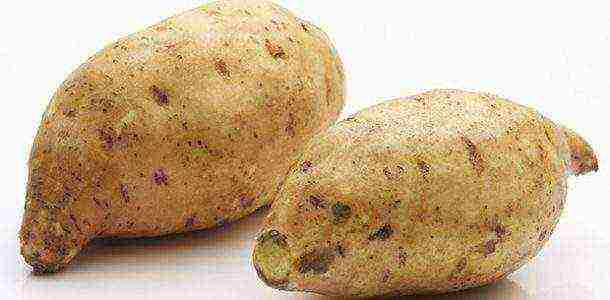
The closest sweet potato hybrid in taste and texture to potatoes. It takes root well on different soils, germinates quickly and gives a stable harvest. Suitable for growing in the middle lane. Tubers are oblong, with light skin and white flesh. After cooking, there is almost no sweetness in it, so the "White" sweet potato can completely replace ordinary potatoes in the diet.
back to content ↑ Fodder sweet potato
Fodder sweet potatoes contain the least amount of sugars and are often substituted for potatoes in various dishes. They have a light flesh, which becomes soft when heated, but not watery, so the tubers are suitable for frying. The fodder sweet potato grows well in the middle lane and in the south.
The most popular varieties of this sweet potato variety are:
back to contents ↑ White bouquet
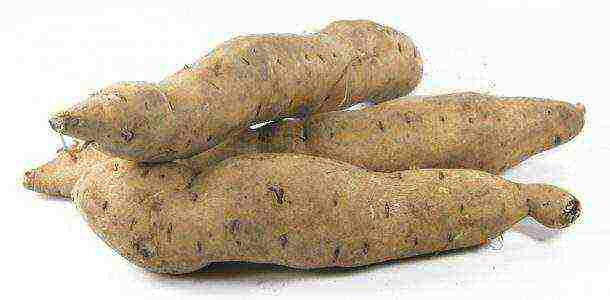
A high-yielding variety that forms a vigorous shrub with long stems. The tubers are large, sometimes they can reach up to 3-4 kg. The fruits have a light, sometimes creamy skin and white flesh. Sweet potato tastes like chestnut, brighter than regular potatoes.
back to contents ↑ Brazilian
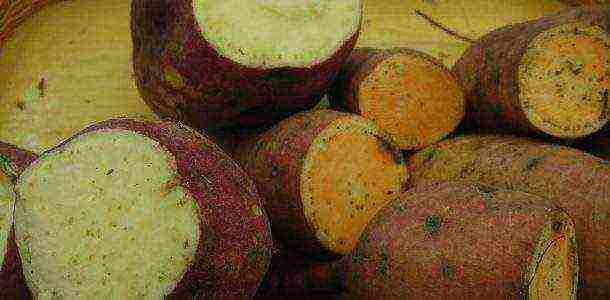
A hybrid that perfectly tolerates not very favorable climatic conditions and takes root well in the middle lane. It gives a consistently high yield, resistant to diseases and pests. The tubers are characterized by a light skin and white flesh with a mild taste.
The sweet potato, despite its thousand-year history, is still a "newcomer" to the gardens of domestic summer residents. However, due to the variety of varieties and tastes, it quickly gains popularity and becomes a favorite of many gardeners.
back to contents ↑ Video tip
If you find an error, please select a piece of text and press Ctrl + Enter.
Sweet potato or sweet potato is a tropical plant that grows well as an annual crop and in our middle lane. This garden crop is widely grown in Asia, Africa, America, and now it has come to our beds!
We wrote about what attracted us to the cultivation of sweet potatoes on the main page of our site.
Sweet potatoes grow like lianas, creeping along the ground, on the roots they form thickenings called tubers (which is not true from a biological point of view, but familiar to the ear), which can be eaten. There are a huge number of varieties in the world with different ripening periods (only the earliest varieties are suitable for Russian conditions, with a vegetation period before harvest of 90-110 days), with different colors of the skin and pulp, and, most importantly, with different tastes. There are varieties that cannot be distinguished from potatoes in taste, there are varieties with a nutty-potato flavor, there are sweetish ones, and there are also very sweet ones, especially loved by children. So you can choose a sweet potato for every taste!
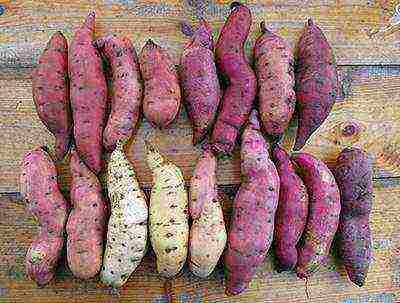
Sweet potato tubers of seventeen different varieties
We, in the Sweet Potatoes, have already grown more than 20 varieties of sweet potatoes, some of them are still in the process of breeding, and some of them we can already share. Our pride is a unique sweet potato with a purple color of its skin and pulp, brought from America in 2012, where it is grown as “food of the future”, rich in vitamins, trace elements and anthocyanins, useful for maintaining visual acuity and slowing down the aging process. We invite you to familiarize yourself with our varieties and choose the ones that suit you. You can choose and order the varieties you are interested in - and we will send you the planting material by mail.
Sweet potato tubers are best bought in the fall after harvest and processing for storage. They do not tolerate temperatures below + 10 * C, therefore, they can only be sent out in the warm season in the fall (October-November). In the spring, you can order cuttings for planting in the garden to get the harvest in the same year. In summer and autumn, you can order cuttings in order to grow a huge sweet potato bush on your windowsill during the winter (with proper lighting and temperature, it grows well as a houseplant), which in the spring can be cut into pieces and used for planting on the garden next spring ...
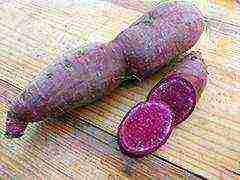 Purple
Purple
For the first time we brought a variety with dark purple pulp from the USA to Russia! Medium ripening, intensively climbing, with unbroken leaves, blooming from mid-summer. Contains a large amount of anthocyanins, which are beneficial for health and prolong life. The magenta color retains well when cooked and looks great on a plate with orange and white sweet potatoes. The taste of the Purple Sweet Potato is reminiscent of the taste of a very noble potato with the addition of chestnuts. Purple sweet potatoes can completely replace potatoes, while positively improving your health. For a good harvest, this variety should be grown through seedlings.
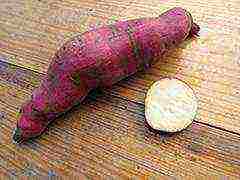 Japanese (Japanese)
Japanese (Japanese)
Brought by us from the USA, early, with red skin and light creamy pulp. The flavor is very different from the usual orange sugary varieties that you can often find in the store. It is less sweet, drier and starchy, similar in taste to potatoes. Like the Purple and White varieties, this is another candidate for a complete replacement of the usual potatoes with a more familiar color for us. Forms lashes intensively, blooms. No seed setting was noticed.
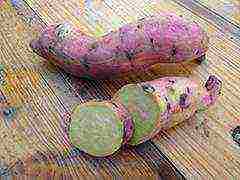 Tainung T-65
Tainung T-65
Developed in Taiwan, imported to Russia from the UK. The earliest of our varieties, which showed itself very well in the beds in the first year. Forms large tubers with pink skin and yellowish sweetish pulp. Intensively forms long thin lashes with bright burgundy stems. No insect or disease damage was noticed. Very promising for growing in the middle lane.
O'Henry
O'Henry is a white variety of the popular Beauregard variety that inherits its yield. Bred in the USA, brought by us from there to Russia. An early sweet potato variety with a slightly yellowish flesh, sweetish taste, dry consistency. The skin is light cream in color. Forms lashes of medium size, the leaf is not dissected, the tubers are aligned.Ripening period 90 days, highly resistant to diseases.
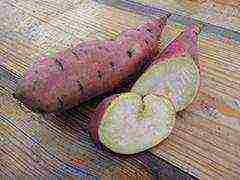 Victory-100
Victory-100
It has become widespread on the territory of Russia. It is a descendant of the famous variety of the 30s and 40s Nancy Hall (Nancy Hall). Light skin, yellowish flesh, sweetish taste. Excellent yields, compact arrangement of tubers under the plant, adaptability to the conditions of Russian lands. Produces good yields even in dry years. One of the few varieties known in Russia until recently.
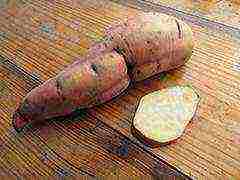 Ginseng Red
Ginseng Red
Another variety widespread in Russia and in the world. Long lashes with bright red stems. The pulp is white-yellow, the skin of the tubers is white-pink. Excellent yield, ribbed tubers, can grow a meter from the parent bush. Bushes are powerful, spreading.
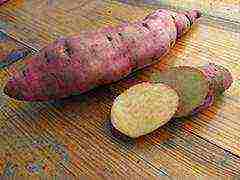 Manchurian
Manchurian
The sweetest of the varieties with a yellowish flesh. Red skin, bright yellow sweet and moist pulp. A very compact bush with lashes up to 1 m, very good yields per bush. Perfect for small areas.
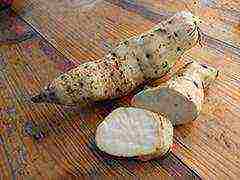 White
White
From the collection of the Novosibirsk Botanical Garden, where the original name of the variety was lost, has since been called simply White. The whitest of our varieties, with minimal sweetness. And if you are looking for a substitute for potatoes in your diet, then this is the White sweet potato. The taste is as close as possible to ordinary potatoes, more likely even of elite varieties. The texture is crumbly. The skin is white, the flesh is white. Very early ripening and very harvestable. It was given to us by Olga Akimova, a sweet potato breeder from Khakassia.
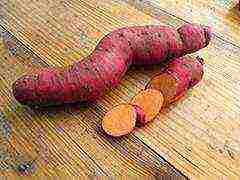 Garnet
Garnet
Brought by us from the USA. Medium-early, excellent sweet taste. It forms a semi-bush with rather long lashes with deeply dissected, very decorative leaves; in the second half of summer it blooms with simple violet-white funnel-shaped flowers, which, when artificially pollinated, can sometimes set seeds. The pulp of the tuber is orange, the skin is orange-reddish. Taste loved by children! The yield is average.
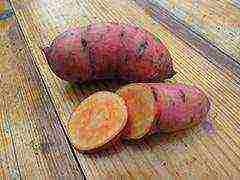 Jewel
Jewel
Developed by North Carolina State University. Brought by us from the USA. This variety is also called the "queen of sweet potatoes". Suitable for a wide variety of conditions and applications. The skin is copper-colored, the flesh is intense orange. The taste is sweet, the consistency is moist. Each bush forms small lashes and a large number of medium-sized tubers underground. For maximum yield, it must be planted, unlike other varieties, closer to each other (at a distance of 15-20 cm). Medium-early, matures in the middle lane.
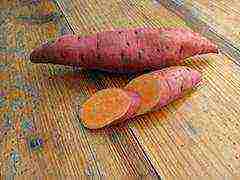 Beauregard
Beauregard
The most widely cultivated sweet potato variety in America and Australia, it is considered a common criterion for taste, texture and size. Bred in Louisiana 1987 for insect resistance, high yield and low cracking. Brought by us from the USA, it now grows successfully in Russian beds. The variety is early, it takes 95-110 days to form a crop. Beauregard has a pinkish or coppery skin and dark orange moist pulp with a sweet taste and dry consistency. It forms whips up to two meters long, the yield is excellent, it increases with a thickened planting, with a distance between plants of 20 cm.
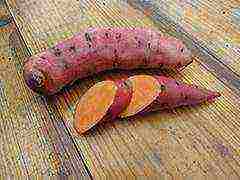 Beauregard Improved
Beauregard Improved
Bred in the UK as a virus-free cell clone of the classic Beauregard, more adapted to the conditions of England. It differs from Beauregard in increased sweetness and moisture of the pulp, and in the lighter color of the tubers. Productivity is above average. The variety was obtained by us from the sweet potato growers from Bashkiria - Polina and Kirill Mavreshko.
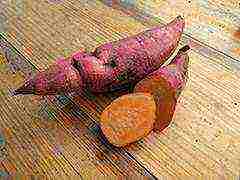 Carolina Ruby
Carolina Ruby
Bred by the University of North Carolina, brought by us from the USA. Early, with dark orange tuber flesh and ruby red skin. Yielding, characterized by a compact arrangement of tubers under the plant. Intensely climbing and actively flowering cultivar. Resistant to fusarium and root rot. The taste of the tubers is sweet, the humidity is medium.When germinating, forms a large number of cuttings.
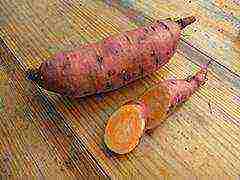 Vardaman
Vardaman
Developed in 1983 by the American Department of Agriculture (USDA), we brought it to Russia from the USA. Bush type plant, medium early. Great for small areas. Leaves are not dissected, with a purple tint, very decorative. Pink-yellow skin, gradually darkening after digging, bright orange flesh. The sweetness is lower than that of Beauregard, which is a recognized standard, close to that of a potato. Popular and common in the United States, great for baking.
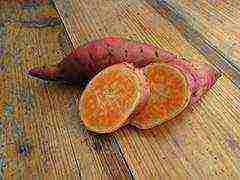 Covington
Covington
Bred in the USA, brought by us to Russia. Differs in excellent yields of flattened tubers with sweet orange flesh. The tubers have a traditional brownish-copper skin color, the flesh is bright orange, sweet and firm. Covington sweet potato tubers have a uniform size and flat surface, and are well stored. Excellent candidate for Beauregard replacement for commercial cultivation.
Welcome to my blog dedicated to His Majesty Sweet Potato. There are thousands of varietal varieties in the world. Sweet potato varieties can differ in the color of the peel and pulp, taste, texture, juiciness, and besides, demanding on soil fertility, watering and climate.
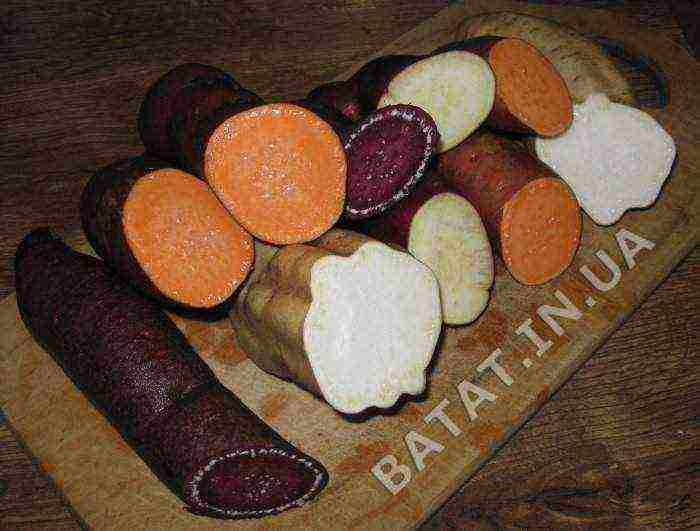
Different colors of sweet potato pulp
In this article, we will talk about sweet potato varieties that are grown in Ukraine and show good results. They came to us from many countries, thanks to enterprising gardeners! Some even remained from the days of the USSR. We managed to keep some names of varieties, others not! And gardeners often forget the names, or even confuse varieties when growing and storing. In this regard, the situation is not very simple 🙂 Okay, let's go!
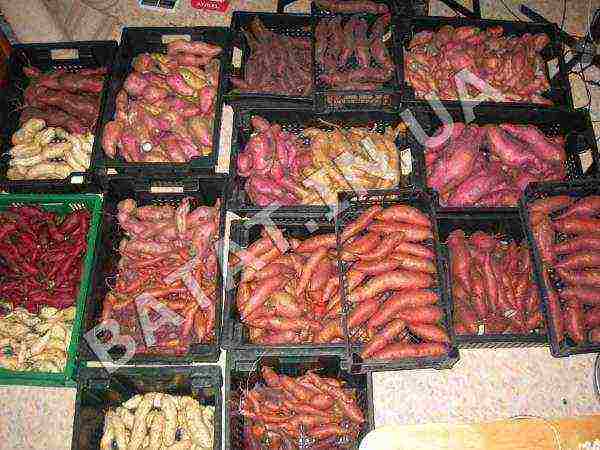
Skin color
Content
Light-fleshed varieties
- Vinnytsia pink
- Ginseng red
- Howe Bay
- Har Bay
- Vinnitsa aborigine
- Manchu unknown
- Buryachny
- White nbs
- Tyung - 65
- Bonita
Varieties with orange
- Beauregard
- Garnet
- Betty
Varieties with purple
- Violet
Sweet potato varieties with light flesh (white, cream, yellowish)
Vinnytsia pink (BP, red gold, gocha, tekken, just pink) - one of the most popular varieties on the territory of Ukraine, in many ways it is the merit of Alexander Vorobyov! I am not ashamed to say - the most unpretentious, adaptable and fruitful variety. Ideal for your first sweet potato experience. Forms a powerful bush, occasionally blooms. The root vegetable has a pink skin and white flesh. Most often forms a compact crop (see photo), with insufficient watering, it can be scattered. Stores well. Good for replacing potatoes in many dishes, delicious raw.
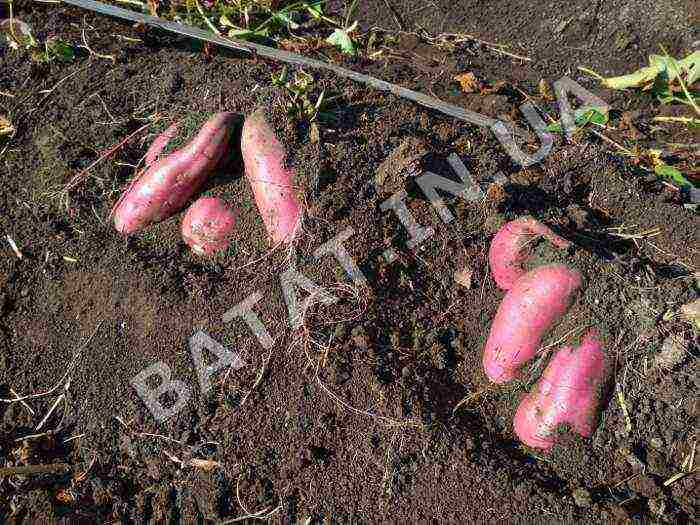
Compactness of tubers

Vinnytsia pink variety
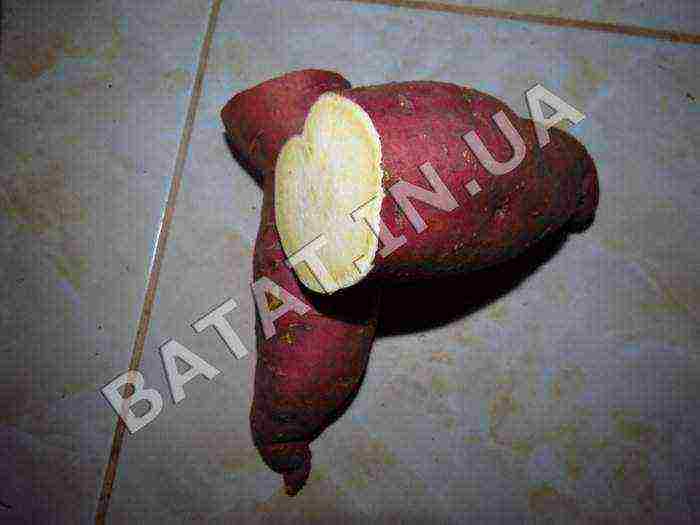
Vinnytsia pink cutaway
Red ginseng (LCD, Afghan) - also one of the most popular varieties of Ukraine. Differs in high productivity. As well as BP can replace traditional potatoes in many dishes. Forms a powerful spreading bush with red stems. The shape of the root crop is from swallow to ribbed. The color of the peel is from light pink to cream, the flesh is white. Stores well. Watch a video about LCD cleaning.
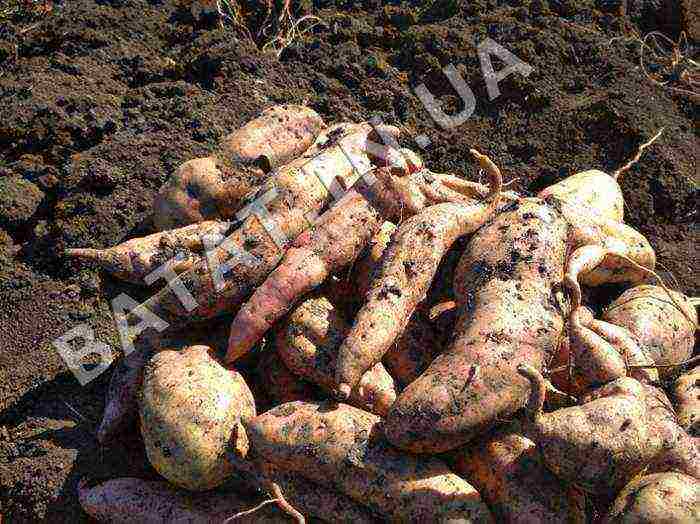
Harvest red ginseng

red ginseng variety
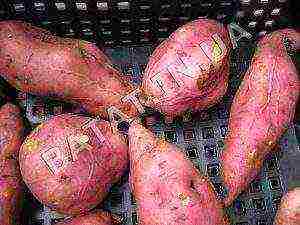
Root crop shape
Howe Bay (Victory 100, Kurdyumovsky) - the variety, as the name implies, takes its source from the East, was grown for many years in the USSR. It got its distribution thanks to the master of the sweet potato grower A.P. Kochetkov. and Kurdyumov N.I. The peel is light pink, the flesh is creamy with orange pigmentation. Good in any form: fried, baked, boiled, except raw (dry starchy taste). It is noteworthy that it germinates at a rather low temperature of 16-18 degrees.
Har bay - a rather tasty dessert variety, white pulp, cream peel. Forms probably the most massive aboveground part that can be used for composting or for animal feed, which is a huge plus.The disadvantages include poor keeping quality and a predisposition to fungal infections. Healthy bushes have good yields.
Vinnitsa aboriginal (VA, Georgia Red, Sukhum yellow) - dessert variety, author's name from Alexander Vorobyov! It forms a small bush, but nevertheless has good yields. Root vegetables have yellow flesh with orange or purple blotches.
Manchu Unknown (Manchurian) - a sort of maternity hospital from eastern countries (as the name implies), was widespread in the USSR. The main advantage is the ultra small size of the bush (important for small areas), but at the same time, large yields. It has a light pink skin and a yellowish juicy flesh. Great for salads, delicious raw. Blooms profusely and knits seeds. Of the minuses, part of the crop withers faster than usual.
Buryachny (Portuguese third (P3), Kiev orange, Kiev Perlina) - P3 is the code name given by the sweet potato breeder Vadim Dzyuban. The pulp is yellow, the peel is the same color as that of a beet, and under the skin layer of about 1 mm it has a purple color. When growing seedlings, cuttings give roots along the entire length of the stem, which is actually unique (usually only from internodes). In the open field forms very thick stems (relative to other varieties). Fairly productive variety under good conditions.
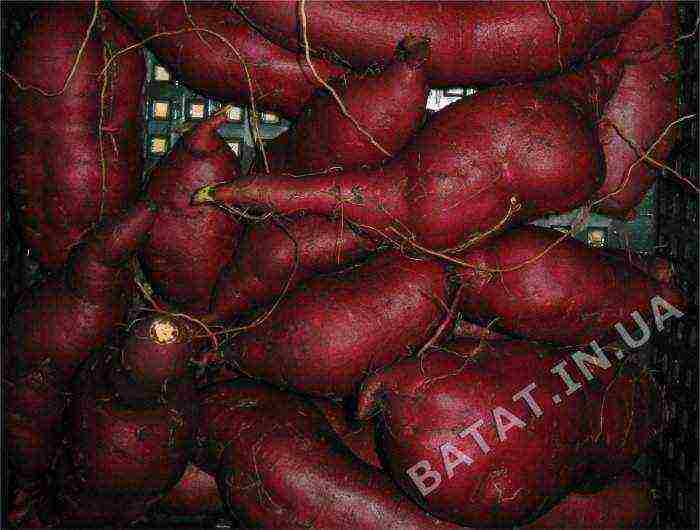
Buryachny variety (Kiev orange, Kiev perlina)
White from the Novosibirsk Botanical Garden (White NBS, Sukhum White) - one of the most fruitful and not sweet varieties! It tastes good raw due to its juiciness. Root crops, depending on the conditions, can acquire a ribbed shape (like red ginseng). Stores well.
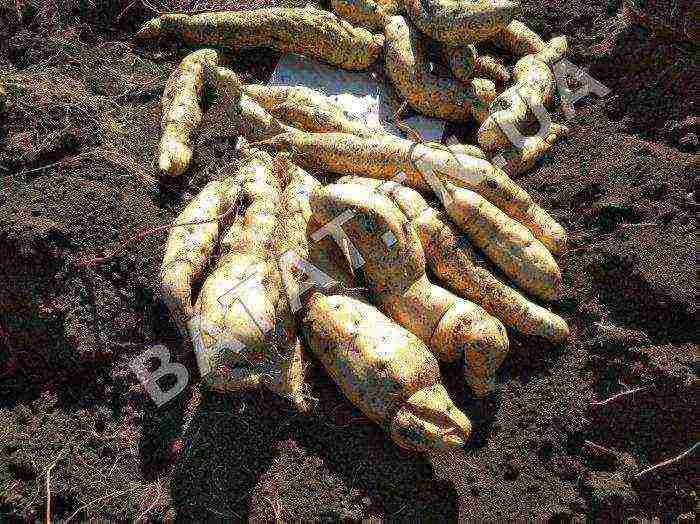
Sukhumi White Harvest (NBS)
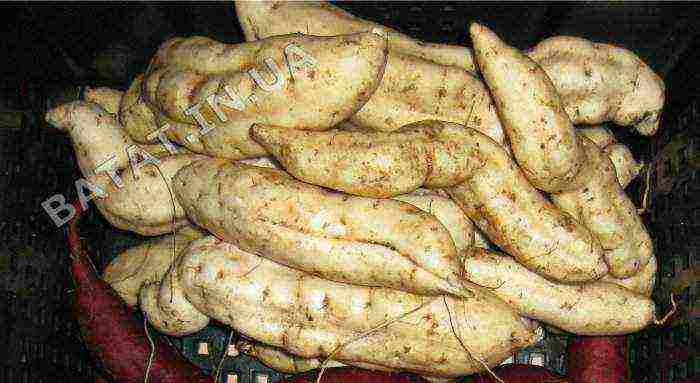
Sukhumi white or white variety from the Novosibirsk Botanical Garden
Tainung 65 (T-65) - a variety of Taiwanese selection. Yielding, usually produces only a few large root crops. Forms very long lashes. One of the earliest, recommended for northern regions.
Bonita - a relatively fresh variety for Ukraine. Shows great promise as the most not sweet sweet potato. It is noteworthy that in the open field it forms several varieties of leaf shapes (on one bush).
Sweet potato varieties with orange flesh
Beauregard - American variety, the standard of sweet potato taste in many countries (especially in the USA). Gained huge distribution in the world due to its taste (when baked, it resembles apricot jam), benefits (rich in beta-carotene), marketable form of root crops (perfectly even of the same shape). Another pluses include: good survival rate of seedlings in hot weather, compact bedding of root crops in the ground, high yield, good keeping quality. It has only one fat minus: it does not give a lot of seedlings, which can be damaged by fungal diseases at the stage of growing it indoors, which cannot be said about open ground.
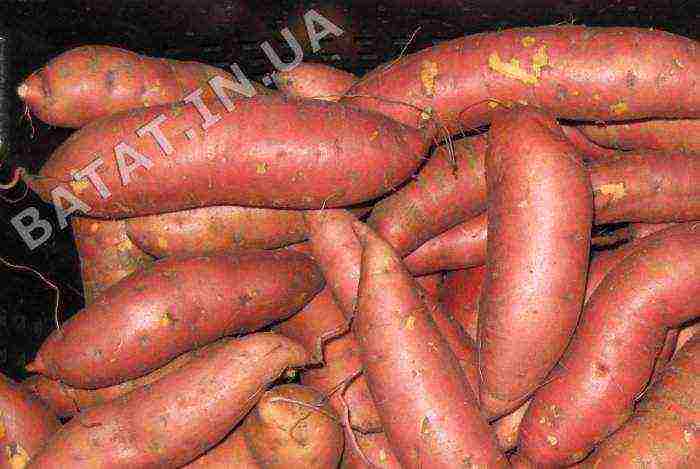
Beauregard variety
Garnet (Diana) - dessert variety with orange pulp, distinguished by high taste. The skin is dark crimson. The leaf shape is decorative, somewhat reminiscent of maple leaves. It blooms profusely in the open field, some seeds usually have time to ripen. It has several drawbacks: unstable yield, elongation of root crops.
Betty - a variety with orange pulp, a distinctive feature of which is the decorativeness of the leaf - somewhat reminiscent of a hemp leaf. It belongs to bush varieties, usually forms a compact bush.
Porto amarelo (P1, Porto Orange) - Portuguese variety with orange pulp and rind. A distinctive feature is the height of the bush - the tallest variety. The leaves have a decorative carved shape.
Sweet potato varieties with purple flesh
Violet (purple, purple, port roshu) - as can be seen from the description, a sweet potato variety with purple flesh. Brought from the USA, but according to some sources it is a descendant of an ancient Japanese variety.The main advantage is the anthocyanins included in the composition (the culprits of such an exotic color), these are antioxidants that preserve visual acuity, suppress the development of cancer cells, slow down aging and strengthen the immune system. Most importantly, all of these benefits are preserved when cooked. In the open field, it blooms and sets seeds (if summer is warm)! It has high taste (but not due to sweetness), it tastes close to the elite varieties of traditional potatoes. Stores well. It has a number of significant disadvantages: a late variety (not very productive in a climate with a short summer), roots are stretched out.
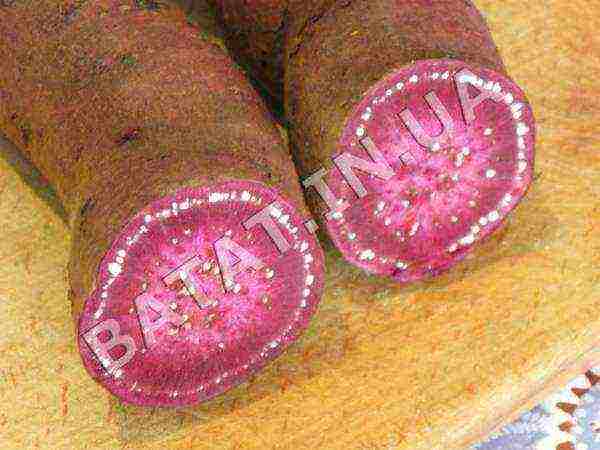
Purple is rich in anthocyanins
Foreword
Among other tuberous crops on any site, the sweet potato or, otherwise, sweet potato, which is a creeping vine with creeping 5-meter shoots, will stand out very strongly.
What is sweet potato and why to grow it
There are tuberous and decorative varieties of sweet potatoes. The first is much more and they are of considerable interest to gardeners. The latter are decorative-leaved, and are good only for creating borders and background plantings in flower beds. There are also differences in the shape of the tubers, which can be round, elongated (fusiform) and even with a ribbed surface. Among other things, sweet potatoes are divided into two groups according to their color inherent in their flesh: the root vegetables can be white, yellow, cream, orange, pink, as well as red and purple.
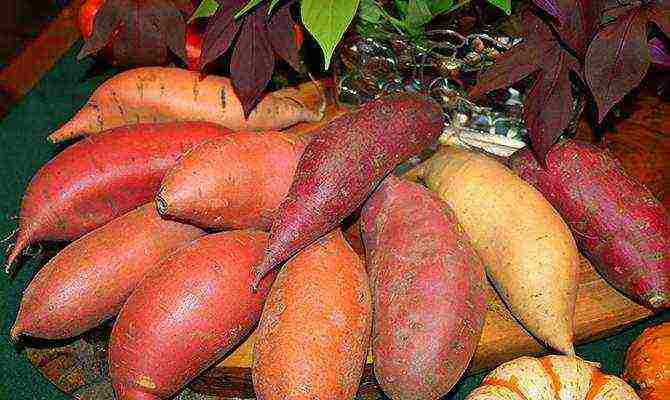
Sweet potato tubers
Tubers in the range from yellow to pink are saturated with beta-carotene, which is a provitamin for vitamin A, so sweet potatoes are much healthier than carrots. Red and purple varieties contain anthocyanins, which do not break down during cooking or frying, and therefore retain antioxidant properties in dishes. That is why the consumption of sweet potatoes can reduce the risk of cancer, reduce the favorable factors for the formation of ulcers, and also provide the prevention of cardiovascular and eye diseases.
Sweet potato varieties, their yield and taste
In regions where the sum of active temperatures rarely exceeds 2000 degrees, and the growing season often lasts no longer than 5 months, the most promising will be the Tainung 65 sweet potato, which ripens in 90-110 days. This vegetable looks like a real liana, as it forms whips up to 4 meters long, which are very convenient to place along the beds. The tubers have a slightly elongated teardrop shape with a roundness in the upper part, their core is creamy, and the skin is pink. From one bush, you can get an average of 1.1-1.2 kilograms of root crops, which are formed from the central buds. Their taste is slightly sweet, pleasant, without flower shades in the finished form, the pulp is moderately juicy.
No less interesting for gardeners is the Purple sweet potato, which spreads lashes 2 meters long from the central rhizome. It was bred in the USA. The tubers are highly elongated, rather easily breakable, the core, like the rind, is distinguished by a pronounced purple color, the intensity of which does not decrease even after cooking. This sweet potato looks very beautiful in the photo and can become a table decoration. Purple is not a juicy variety, its flesh is rather dry. Delicious when cooked, especially if baked. The taste is reminiscent of the best potatoes with a slight hint of chestnut, almost no sweetness. To get good yields, it is recommended to grow this vegetable from seedlings.
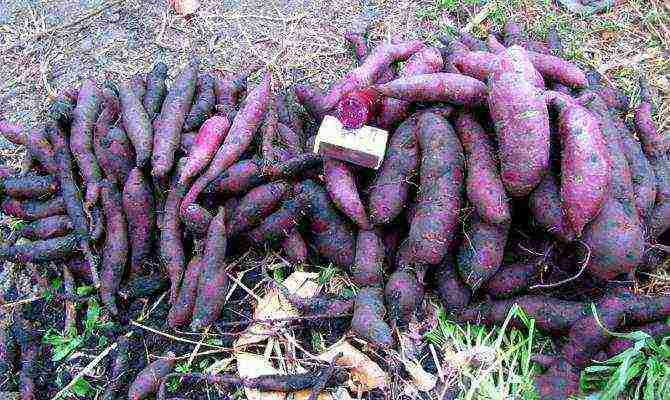
Sweet potato "Purple"
Japanese yam is also considered to be very productive, although its tubers are quite small, weigh about 100 grams, up to 0.5 kilograms of root crops can be harvested from each bush. One of the few flowering varieties, beautiful in the photo, but does not give seeds, so it is grown by cuttings. The liana's lashes are not very long, up to a meter, the tubers are formed compactly under the central rosette of leaves.The peel is red, and the core is light yellow; externally, the roots strongly resemble potatoes, however, as well as to taste. The pulp is very dry, starchy, the juice almost does not stand out when broken, the sweetness is not felt. The variety is resistant to wireworm damage.
And another promising sweet potato for cultivation is Pobeda 100. This vegetable was bred in the USSR and to this day it successfully competes with potatoes in the plots of many gardeners. This vine is not too long, up to 2 meters, roots and oblong roots are formed along the entire length, while the tubers grow in a compact bunch very close to the surface. The growing season lasts 118 days on average. The variety is drought-resistant, while from one bush you can get up to 1.2 kilograms of tubers. The peel of the root crops is pink, the flesh is yellowish-orange with pink blotches. The taste is pleasant, somewhat sweet.
The sweetest sweet potatoes for your garden
Above, we examined the varieties of sweet potatoes that can replace potatoes. Now let's look at those varieties that can be called dessert, that is, the sweetest. Someone may have a reasonable question, why plant root vegetables of a high degree of sweetness, which may taste like slightly frozen potatoes. The fact is that when boiled, they become very tasty. Alternatively, they can be fried before caramelizing, or simply stewed with carrots for a semi-sweet dish that kids will surely enjoy.
The Manchurian variety is considered the sweetest, which outwardly resembles oblong potato tubers with pink skin, its flesh is yellow, juicy. The liana scatters its lashes short, up to 1 meter, the roots form a compact bunch in the central rhizome, its weight can reach 3.5 kilos. The vegetative period is about 90 days, that is, it belongs to the early ripening varieties. It is an ornamental-leaved flowering plant that begs for in the photo, but at the same time it is also very fruitful. The vegetable requires frequent feeding. When growing sweet potatoes, a mixture of ammophos (0.156 kilos), ammonium nitrate (0.374 kilos), magnesium sulfate (0.177 kilos) and potassium sulfate (0.292 kilos), with the addition of molybdic acid in an amount of 2 grams and borax - 2.7 grams, showed itself well.
The high degree of sweetness differs from many other varieties Beauregard and Beauregard Improved. The difference between them is only in the content of sugars, in the first they are slightly less. It is noteworthy that in order to obtain a large harvest, it is necessary to do a thickened planting, leaving a gap of 20-25 centimeters between the cuttings (you can even 15 centimeters, but frequent feeding will be required). Root crops ripen in about 90-105 days, they are elongated, fusiform, with smooth sides. The skin is brownish red and the core is orange. Because of its sweetness, this vegetable often attracts the attention of wireworms and grubs.
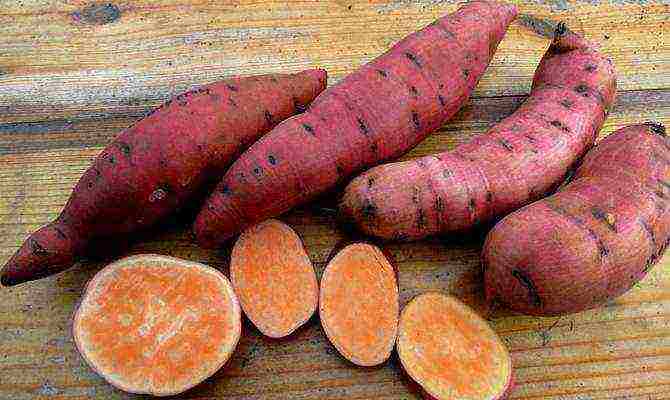
Sweet potato "Beauregard improved"
Jewel has similar qualities and cultivation technology to Beauregard. It is also planted at small intervals, about 15–20 centimeters. The only difference is in the shape, the roots of this sweet potato are more rounded, less elongated. But the color of the peel and core is very similar, however, the pulp is paler, but very sweet and juicy. The vegetable is perfect for caramelizing, stewing in the oven by cutting into circles. The high sweetness attracts pests such as the wireworm or the beetle larva, and is not affected by the root nematode. Also, this sweet potato is vulnerable to soil and black rot. The growing season is about 100 days, that is, it belongs to the very early, root crops form a dense group of medium tubers under the central rosette of the bush.
It should be noted that the sweetest varieties of sweet potatoes are those with an orange heart.
Georgia Red sweet potato, also known as Sukhumi Yellow, is very interesting. Its ripening period is rather short - from 85 to 110 days, depending on the climatic features of the area.Liana scatters shoots 2 meters, thickening of the roots, which, in fact, are mistakenly called tubers, are formed in rather compact groups, about 1 kilogram of root crops can be collected from one bush. The skin is brown, and the core is yellow with bright orange splashes. When raw, this vegetable tastes like potatoes, but a very high sweetness appears during the heat treatment, and this is precisely the peculiarity of the Georgia Red variety.
How to properly grow sweet potatoes with low solar activity
Since the homeland of this plant is Peru and Colombia, that is, countries with a very warm, even hot climate, you should plant sweet potatoes only when you are sure that there will be no more late frosts. This plant stops developing when the temperature drops below 20 degrees. The best conditions for growing sweet potatoes are 25-30 degrees. It should be borne in mind that sexual reproduction in cultivated varieties is practically absent, with rare exceptions, therefore this vegetable is planted by cuttings.
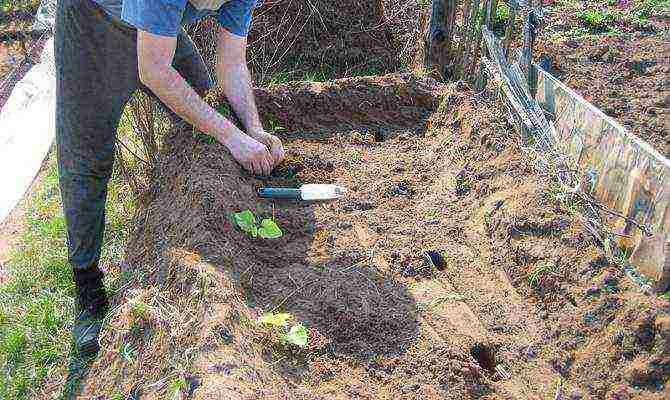
Planting a vegetable by cuttings
The preparation for planting potatoes is very different from the same process for the sweet potato. It is recommended 5 weeks before planting to place the selected tubers for germination in pots with fertilized soil, it is possible with a small admixture of peat, in which there is a lot of organic matter. You need a mixture of minerals. For example: molybdic acid (1.3 grams), boric acid (2.7 grams), ferrous sulfate (31.9 grams), manganese sulfate (3.2 grams), zinc and copper sulfate (2.1 and 1, respectively, 1 gram). This mixture is dissolved in 10 liters of water and used for irrigation. The grown shoots are cut off and transferred without rooting into well-moistened holes, where they are covered with fertilized soil to a third of their length, which usually corresponds to 20-30 centimeters.
The ideal time for landing in latitudes close to the north is the first decade of June, when the May frosts are behind. From 1.5 to 2 months, daily watering is necessary, although there are drought-resistant varieties that are undemanding to frequent soil moisture. If in your area the temperatures are low even in summer, you need to cover the bed with black film so that the green mass remains over the shelter. This will allow the soil to warm up better and provide a higher yield.
The period immediately after harvest is very important. At this time, the skin of the root vegetables is very thin, and a “treatment” procedure must be carried out. It consists in placing the tubers in a humid environment at a high temperature (at least 30 degrees). For this purpose, you can use a whole room, for example, a steam room in a bath, but it is better to use a large box or chest, placing trays of water on the bottom, and oil heaters along the walls. In a week, the peel of root crops will become thicker and at the same time it will restore all defects itself, which will ensure long-term storage.
Rate the article:
(0 votes, average: 0 out of 5)
